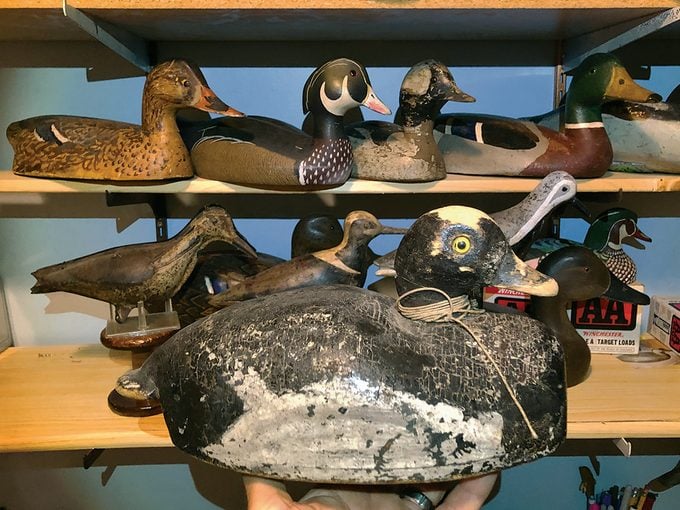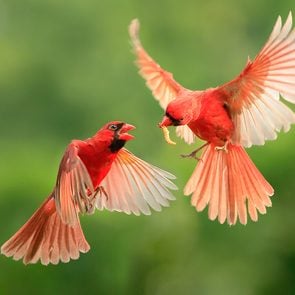These Antique Duck Decoys Are Truly Works of Art
For this passionate collector, tracking down vintage wooden duck decoys has been a lifelong treasure hunt.

Collecting Duck Decoys
I was 20 years old and home from college when I asked my father if I could borrow his duck decoys for hunting. He said I’d started my new life as an adult, and it was time to use my own!
I put an ad in the local paper. Next thing you know, I was inundated by people wanting to sell their wooden duck decoys to replace them with plastic ones. I appreciated the unique art form of each wooden decoy, and I was intrigued as to why there were so many different-looking ones to represent the same species of duck.
I am now in my 60s. It’s been a wonderful journey of learning and sharing Canada’s unique art form of antique duck decoys with people from across Canada and around the world.
Like a Duck to Water
Old wooden duck and bird decoys were created to invite wild game home for dinner by fooling them into thinking they were looking at a real bird. Each one is a unique work of art, and finding them has been a lifelong treasure hunt. How many people can say they’ve been hunting treasure most of their adult life?
I have many items in my collection that were made when wooden decoys were most widely used, between 1850 and 1940. At any one time, I have over 500 decoys, and I do trade them or, rarely, sell one or two. Often I will give one to a family member of the original carver.
I’ve displayed my decoys at hundreds of venues, including museums. I love having large numbers on hand so that when I’m asked to put on a display, I can bring some from that specific area.
Wooden decoys are very regional in style. Toronto and Hamilton-area decoys are very different from those crafted in Belleville or Trenton, for instance. Most decoys from Quebec have additional carvings on their bodies and heads.

Ducks in a Row
Every decoy has its own story, which can sometimes speak volumes to a trained eye. My personal favourite is a bluebill made by Ambro Smith of Trenton, Ontario, in the late 1880s (above). It was given to me over 45 years ago by an elderly gentleman, and I later met a number of his relatives as I learned more and more about the maker and his history.
Most old hunting decoys in Canada are valued from $50 to $100. Rare ones can be valued in the high hundreds, and some that are well-documented and in excellent condition could go for as much as $20,000—but you aren’t likely to find one of those in someone’s attic these days.
Perhaps you have a decoy or two in your cottage, garage, barn or basement. Don’t be fooled! A decoy is not just a beautiful old bird. It has history, and maybe value.
So which decoy in my own collection is the most valuable? I never like answering this question, just in case I leave my door open someday. The most valuable Canadian decoy ever sold was worth more than $200,000, and the most expensive one in North America went for nearly one million dollars. I don’t have any of those!
To me, in any case, a dollar figure is less important than a decoy’s historical value.

One Lucky Duck
It’s with great pleasure that I help people daily with their decoy questions. I field many inquiries from people of all walks of life, from famous movie stars to regular folks like you and me.
I have seen magnificent, valuable, historical decoys in tiny shacks and cottages, and some very ordinary ones in opulent mansions.
Sometimes folks have had a decoy in their family for a number of generations and always wondered where it came from or who carved it. I can often help them in just a few minutes.
My wife says there’s never a day that goes by that I don’t help people identify decoys for free.
I believe giving is far more important than taking in this world. I became an expert inadvertently by answering questions with my limited knowledge 45 years ago. By sharing my knowledge and offering help to all who asked, I was gifted with more knowledge than I could share.
I spent most of my life as a front-line worker caring for wonderful people with developmental disabilities at institutions and private homes. I live and breathe helping people, and helping people with duck decoys is just an extension of my personality.
My gift has been not only the pleasure of helping thousands of decoy owners but of meeting so many amazing people and hearing their stories about waterfowl hunting in Canada.
There is no doubt that if anyone collects and talks about the same thing for 45 years, they are either the best at what they do or a little bit crazy.
I admit I am probably both.
Appraising Duck Decoys
Is there a duck decoy tucked away in your cottage, garage, barn or basement? Below are Steven’s first steps for checking if you have a gem on your hands. When in doubt, contact an expert!
Who made it?
Determine a history of sale for a similar decoy by the same carver or maker. Keep in mind that since decoys were considered tools rather than works of art, very few were identified by the carvers. They often have initials carved or painted on them, but these usually indicate the hunter, not the carver.
Assess its condition
A very small bit of damage can devalue the decoy up to 90 per cent. Sad but true.
Determine its rarity
If a carver only made one or two of a specific species of bird, then collectors may get very excited at an auction sale knowing they may have a one-of-a-kind decoy.
Next, discover 20 mind-blowing artifacts you’ll find in Canadian museums.






